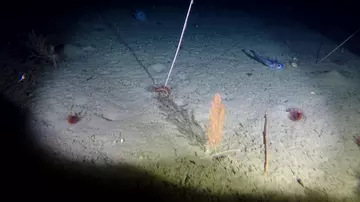
Dr Stephen Long
Post-doctoral Research Associate
ZSL scientists have recently returned from a research cruise aboard the RV Tarajoq in the Davis Strait, west Greenland. The aim was to learn more about deep-sea habitats containing the coral Balticina finmarchica, a delicate sea pen which can extend up to a meter from the seafloor…
The Northwest Atlantic’s Davis Strait, lies between Greenland and Canada, straddling the Arctic Circle. The deep, dark, cold waters of the Davis Strait are home to shoals of Greenland halibut (Reinhardtius hippoglossoides); a large predatory flatfish that feeds on fish, prawns and squid. Since the mid-1960s, they have been the target of offshore fishing trawlers, towing nets along the seafloor. The offshore fishery for halibut is now an important part of Greenland’s economy, and since 2017 it has been certified as a sustainable fishery by the Marine Stewardship Council.
Despite supporting an important commercial fishery, until recently, relatively little was known about the deep-sea habitats in this region. A condition of certification was to improve scientific knowledge about both the nature of seafloor habitats and the impacts of trawling. Since 2017, scientists at the Zoological Society of London have been using a deep-sea video sled to address these knowledge gaps. So far, imagery from 94 video stations has been used to describe habitats, assess the impacts of trawling and identify potential vulnerable marine ecosystems (those ecosystems that are ecological important and particularly sensitive to disturbance).

What do we know about B. finmarchica sea pens?
In our existing imagery, we noticed that B. finmarchica sea pens were only present at a small number of the sites. Notably, the largest specimens were only observed outside of the fishery. Rarer still were sea pen ‘fields’: sites where the density of sea pens was as high as 4.5 individuals per m2. Naturally, the footage of these previously unseen habitats posed more questions than they answered. How rare are these sea pens fields? How far do they extend? What is the impact of trawling on sea pen populations? How well are they protected by existing management measures?

What was the aim of the research cruise?
In October 2022, we boarded RV Tarajoq, the Greenlandic research vessel whose job it is to assess the halibut stock and determine a sustainable quota for the fishery. Tagging along we hoped to deploy the video sled where we were most likely to encounter these sea pens, to address those unanswered questions…Of course the weather had other plans: winds in excess of 50 mph, driving waves of over 5 m, forced us to retreat to the shelter of a fjord. Nevertheless, by keeping an eye on the weather forecast and working closely with Rune, the ship’s Faroese captain, we were able to gather imagery from 11 new sites, setting a new depth record for our equipment of 1,640 m.

Back in London, the next step is to work painstakingly through the imagery, gathering data about the sea pens and the communities in which they occur. Once carefully analysed, this new information will be shared with the authorities and industry, hopefully informing evidence-based management and ensuring that the impacts of the fishery remain sustainable.

You can find out more about our work in Greenland here, or try playing Tricky Trawling, our sustainable fishing game.
